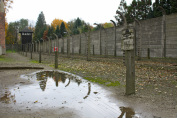
themselves, often shoeless, along frozen roads, one pain-filled step promising but another, one pain-filled day yielding seemingly inevitably but another. The women had no known destination, no end point in sight. Every step required the marshaling of their energies, for they were at best listless, in their emaciated and diseased conditions.
Every dawn saw them awake to gnawing hunger, swollen and pus-filled feet, limbs that no longer functioned, and open wounds that would not heal. They knew that an entire day’s march stood before them, during which they would be given by their tormentors few opportunities to rest. Perhaps, when evening finally came, they would consume a few morsels of food. They would then end the day in shivering, pain-filled half-sleep, only to awaken to the
repetition of another day’s and night’s cycle of horrors.”
An American army physician, upon arriving to liberate these captives, described his initial view of them, “My first glance at these individuals was one of extreme shock not ever believing that a human being can be degraded, can be starved, can be so skinny and even live under such circumstances.” This report is from Hitler’s Willing Executioners, an award-winning book by Daniel
Goldhagen.
The Helmbrechts concentration camp in northern Germany was founded in the summer of 1944 and housed about 1200 women prisoners – mostly from Poland and Russia – who worked in the German Neumeyer armaments firm. When this camp was threatened by the advancing armies of Russia from the east and the Allied forces from the west, the guards were ordered to begin a “death” march, forcing the women to walk hundreds of miles south. This march began on April 13, 1945.
The women, many shoeless and wearing threadbare clothing, marched for miles each day – enduring incessant cruelty from both male and female guards. If they disobeyed orders – such as slowing down or eating scraps of food on the ground – they were beaten to death or shot. Many died on the way.
By May 6, the day when the Americans liberated the survivors, the women had marched 195 miles to an area near the Czech border. Even after liberation, many died of medical complications after the march ended. These women were Poles, Russians, Jews, and even Germans who objected to Hitler’s policies. They did not die in vain for they give us a way to evaluate our own troubles.
Yes, we never can avoid stress but we can realize that stress is
relative. And, when compared to the atrocities that these brave women endured,
our struggles are minimal. So the next time someone cuts you off in traffic or a
co-worker does something obnoxious or your teenager explodes, think about these
women marching, shoeless or with only rags to cover their swollen feet, being
clubbed by German guards. Everything is relative.

 RSS Feed
RSS Feed